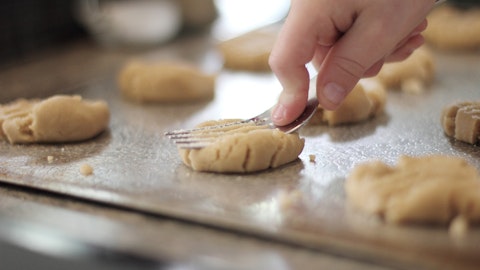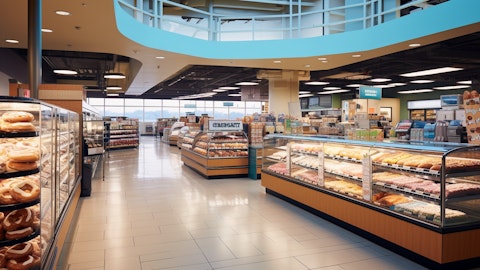Unknown Analyst: Hey, this is David Shakno, stepping in for Jon Andersen. Could you talk about price and volume a little bit? If I recall from the last call, you mentioned you were looking at some areas to take pricing in calendar ’24? And then I just wanted to understand also how you’re looking at volumes for the balance of the year?
Ken Plunk: Yeah. Well, what I can tell you, volume for the quarter, again, it can vary somewhat a little bit depending on the business and channel. But overall, volume was down 1% to 2%, depending on what area of business you’re in. Again, I think kind of speaks to some of the things that we talked about, David, with the consumer. So if you just kind of look at that number against where we landed at negative 0.9, you can kind of get some idea of the price benefit overall for the company. As you look forward, we did take a price increase in January in our ICEE business. We took a price increase in January or December as well. And then on the snack food side, you got a lot of — you’ve got some commodities with deflation, you got some with inflation.
So we’re kind of taking a surgical approach to that, David and really looking case by case, where we think we’ve got a place to increase price, but the market has an opinion on that as well in terms of price points. So that’s kind of what’s been done and what’s planned. As we look forward on volume, I would just kind of echo what Dan said, we’re coming out of a quarter that makes us a bit cautious. We have data that we’re looking at each and every week to get a sense of kind of where the consumer is at when you get into spring, we’re hoping that, that kind of launches people getting out and will benefit our business. But if I was looking forward, there might be some slight improvement in volume, but I think we’re still cautious about what’s out there in front of us.
Unknown Analyst: For that price increase on ICEE in January, should we think of that similar to, I think, the price increases the past couple of years each January, so that has been mid-single digits or so. Correct me if I’m wrong. Should we be thinking about it roughly the same again?
Ken Plunk: Probably not quite as high as the last 2 years where we were with inflation, but some are in that mid-single digit, maybe a hair under that, probably David, is the way to think about that.
Unknown Analyst: Great. And then one other thing, if I can. Historically, second half gross margins, those tend to be, I think, 200 to 300 bps higher than the first half just with one quarter down here for the fiscal year. Are you still kind of expecting that cadence for the second half of fiscal ’24? And then regardless, can you just kind of outline some of the puts and takes there? I know you mentioned a little bit on the pricing question about commodities. But if you could just kind of outline that in general, that would be great.
Ken Plunk: Yeah. Yeah, we still feel really good about what we’re doing as it relates to driving profit margins. We actually — we’re very happy with gross profit for this quarter even with some of the challenges on the sell side that we exceeded our internal budgets on that. We saw our bakery gross margins improved over 100 basis points strong margin performance in ICEE and in Food Service. So we like what we’re doing. I think the initiatives we mentioned are working. What we’re focused on is mixing out better. And then to your point, as we get into Q2 and particularly in three and four, those will make in much heavier ICEE, much heavier Dippin’ Dots, which are some of our highest margin businesses, and we expect that to generate those 30%-plus gross margin that we did a year ago.
And so we see no reason to back off of kind of what we’ve talked about, which is getting above 30 for the year. And we think what we’ve done in the first quarter is a good sign that we’re moving in the right direction on that.
Unknown Analyst: Got it. Great. That’s all for me. I’ll pass it on.
Dan Fachner : Thank you, David.
Operator: Thank you. Our next question comes from the line of Connor Rattigan of Consumer Edge. Your question please, Connor.
Connor Rattigan : Hey, guys. Good morning.
Dan Fachner : Good morning, Connor.
Connor Rattigan : Yeah. So I just wanted to touch on the top-line a little bit, specifically on the Food Service pressure. So I guess first thing first, I guess, was this more isolated to maybe a select channel or a customer? Or was it maybe a more broad-based pullback? And also, was there any deflationary pricing involved in there?
Dan Fachner : There really was no deflationary pricing involved in it at all. We talked about Food Service being affected and really being affected through our pies and cookies. And so if you looked at it surgically, that had a pretty sizable impact on where we were off and saw that in inventory reductions as early as early December, late November, started to see that. And that’s real. Again, I mentioned this earlier, we looked at some IRI and Circana data and our volume looks good through that. And so you know that these inventories were pulled back. And so we don’t over complicate it. We think the consumer is cautious as we’ve said already, but we really do feel like a good portion of this is inventory related.
Ken Plunk: And just to magnify, you’re trying to get into kind of particular product areas. The pie decline was the majority of the decline in bakery year-over-year. And then we mentioned cookies on top of that. But that’s a product that once it gets on display and retailers as a shorter shelf life and so as they start to see retailers and grocery stores, concerns about traffic coming into the holidays, they backed down their orders. And so that was a big number in terms of year-over-year comparison.
Connor Rattigan : Got it. So I guess it sounds like more the inventory and deload that you saw there on the pies and whatnot, it could be more of a onetime headwind and nothing to persist throughout the balance of the year. Is that fair?
Dan Fachner : We believe that to be true. Certainly, we’re going to come off a quarter and be cautious about that, right, and watch it really, really closely and why we’re looking at all the different data points that we can find, but yes, we do believe that. And remember, pies business is really a onetime a year business, too, that doesn’t stretch out for four quarters.
Connor Rattigan : Got it. Got it. And then just one more for me that I’ll squeeze in. So a pretty significant step-up in marketing in the quarter. I mean, can you maybe touch on some of your initiatives there? And I guess, maybe what we should expect for the balance of the year? And do you maybe see a need to spend more or maybe do some more advertising sort of in light of the slowing traffic and consumption?
Ken Plunk: Yeah. We — I think we talked about this before, Connor. We love what we’re doing in terms of marketing Lynwood and his marketing team have really done a great job of both with our new products and with brands that we had are really investing and getting a lot out of those investments to ground growth. And we believe that is a key to us continuing to build these brands and grow. And so we continue to invest accordingly. Just remember a lot of those — the spend of that has impacts and benefits to the rest of the year and even beyond that. So it’s not always just a contained into a quarter-by-quarter kind of thing. It’s also against our — one of our lowest sales bases. When you look at Quarter1, Quarter2 will be much the same. You’ve got that kind of spend a lower sales base. So that should level its way out as we get through the year and ultimately in the year, probably in that low to 7.1% to 7.12% of sales range.
Connor Rattigan : Thanks for the color both guys. Appreciate it. I’ll pass the line.
Dan Fachner : Thank you, Connor.
Operator: Thank you. Please standby for our next question. Our next question comes from the line of Robert Dickerson of Jefferies. Your line is open, Robert.
Robert Dickerson : Great. Thanks so much. Hey, guys. I guess just to kind of circle back to the — like the pies and the cookies situation relative to kind of what I’m hearing around maybe new distribution potential at Subway and kind of new distribution kind of potential overall. Maybe just provide some color as to kind of how you see the portfolio performing or recently performing maybe like a branded versus non-branded basis, right? Because I’m asking because I hear SUPERPRETZEL is doing great, right? ICEE still doing pretty well. So it almost sounds like there’s maybe a little bit more momentum on the branded side versus the non-branded side. And usually, that also provides some positive mix — margin mix uplift overtime. So just any updated thoughts there would be great. Thanks.
Dan Fachner : Rob, that’s a really good question. You know this. We’ve talked about it several times. I love branded products, right? I love the fact that we have an opportunity to get out there and advertise and market our branded products. And I think our team is doing that really, really well. Within our brands like SUPERPRETZEL, we’ve been able to release some really good new products that are being really well accepted out in the industry. And so I think we’re seeing some nice lifts from that like the Bavarian sticks. Almost feels like a natural that we should have done it maybe prior to this, but everything is about timing. And so I do like where our branded products are going and think we have some real opportunities.


